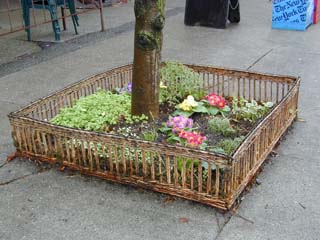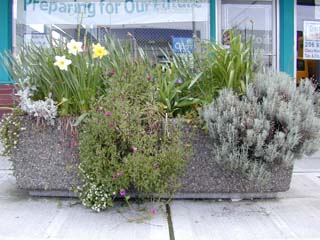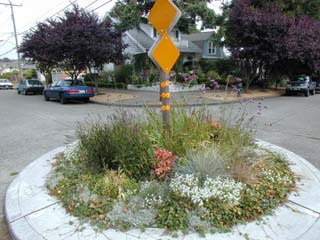
Surveys
DJC.COM
April 22, 2004
Gardeners go trowel to trowel in contest
Seattle Department of Transportation

Photos courtesy of SDOT
The Seattle Department of Transportation’s 2004 Streetside Garden Contest will be held in June. It honors volunteers who maintain public spaces, such as this tree planter in Fremont.
|
Like a spring bouquet, the plantings in curb bulbs, traffic circles and planting strips are gifts from businesses or gardeners that share the beauty of nature with the public.
The Seattle Department of Transportation (SDOT) understands the challenges of streetside gardening. Its 10 gardeners work hard to steward more than 50 acres of street right of way, ranging from pocket plantings along Aurora Avenue to the Beacon Avenue medians and an assortment of triangles scattered all over town.
SDOT can't do it alone
SDOT started the first citywide Streetside Garden Contest two years ago to recognize the public's role in beautifying Seattle's streets. Almost 1,000 volunteers assist the department as streetside garden stewards. These intrepid gardeners face frequent frustration as their streetside gardens are often run over, which compacts soil and crushes plants, and often curbs enthusiasm and commitment.
Despite the challenges, gardeners who hang in long enough to see their gardens bloom enjoy expanding their gardening space, meeting new friends and making their neighborhood safer.
Looking for a few good gardeners

This planter box can be found on California Avenue Southwest in West Seattle’s business district. Dennis Ross and Mark Sindell won an award last year for similar improvements along Admiral Way.
|
This year's contest is the third of what is shaping up to be an annual event. Streetside gardeners are invited to enter their gardens in this year's contest. The public can also nominate a garden that has caught their eye or been transformed from a neighborhood eyesore. It's easy to do with an online entry form available at www.seattle.gov/ transportation/trafficcircles.htm.
Qualifying gardens
To qualify for Seattle's contest, gardens must be located within the city limits. Mature trees should be limbed up to 8 feet at the trunk and young trees pruned so they don't block visibility. Gardens within 30 feet of an intersection cannot contain any unapproved objects such as rocks or posts and understory plants must be maintained at or below 24 inches. The understory plant height for streetside gardens beyond the 30-foot envelope is a maximum of 30 inches tall.
Judging criteria
Judges are professional landscape designers, architects and community members. They will be evaluating use of color and foliage, seasonal interest, quality of maintenance and plant health, and good gardening practices. The finalists will represent the best of unique design and personality, as well as their choice of plant selection, with emphasis on drought tolerance, pest and disease resistance.
Past winners
Last year, 14 neighborhoods entered the Streetside Gardening contest in categories such as Car Stoppin' Gorgeous, Just for Fun, Gateway Planting and Multi-Season Spectacular.
Readers can go “island hoping” by taking a photo tour of past contest winners at www.seattle.gov/transportation/streetsidearchive.htm.
Seattle is tops in traffic circles

Traffic circles, similar to this one in Fremont, are frequently entered into the contest. |
Seattle is nationally recognized for its traffic circle program, which has been shown to reduce collisions by 90 percent.
Traffic circles are raised areas surrounded by curbing and are located in the center of street intersections. Seattle's first traffic circle was installed in 1973 on Capitol Hill and a full program has been in place for 25 years. Today there are over 900 circles in the city.
Circles begin with a request
The construction feasibility of circles, and other traffic calming devices, such as chicanes, medians and triangles, is based on the history of accidents and the speed and volume of traffic at the intersection. SDOT prioritizes those areas based on investigations.
Most of the traffic circles are built at the request of neighborhood groups, and many want their circle landscaped. If the neighbors agree to plant and maintain, the department will provide the first batch of plants.
Planting for safety and sustainability
Landscaping traffic circles improves their effectiveness to reduce speeds as well as supports Mayor Nickels' goals of creating clean, green, livable urban neighborhoods. When circles are landscaped, they help to visually break the street into shorter segments, which can encourage motorists to drive slower.
Plants are supplied to volunteers getting a new traffic calming device. I and my assistant, Melissa Brown, work with residents to help them plan what will go into the circle. Plants are chosen based on their drought tolerance, pest resistance and mature height. A list of recommended plants is available at www.seattle.gov/transportation/docs/PlantList_03_04.pdf.
We encourage garden design that requires minimal tending, knowing that people frequently move and our program has little funding for maintenance. That was part of the impetus for SDOT's Streetside Steward program.
Gardens as varied as the gardeners
Not everyone shares my desire for minimal maintenance. Hank Bobala, who gardens in a traffic circle at 17th Avenue Northeast and Northeast 113th Street, and has been a winner two years in a row, likes seasonal variety. Bobala changes out his plantings quarterly, which allows him to use exotic plants that would otherwise get too tall or not last through the winter.
Hundreds of stewards wanted
At the other extreme, many circle gardens have lost their stewards and need a new volunteer. There are easily 300 of these gardens suffering from weeds and neglect. SDOT posts signs asking for volunteers to contact them. If neighbors have any questions about taking over an abandoned streetside circle garden, they can call (206) 684-5008.
Business and community sponsors
The Streetside Gardening contest is sponsored by the Seattle Department of Transportation, with additional sponsorship from Seattle Public Utilities, the King County Chapter of the Washington Association of Landscape Professionals, Washington Chapter of the American Society of Landscape Architects, the West Seattle Garden Club, Northwest Garden News, Swanson's Nursery, Cedar Grove Composting, Walt's Organic Fertilizer, Friends of P-Patch, and others who have donated certificates and items for awards and door prizes.
Liz Ellis started the Streetside Steward Program to provide support and education to community volunteers.
Other Stories:
- Shared streets can provide open space, too
- Art meets Frisbees in north Seattle park
- What is your landscape telling you?
- Seattle's big chance to reconnect the waterfront
- Keeping runoff out of sight, but still in mind
- Ecological restoration goes beyond trees and shrubs
- Amgen unwraps the landscape at Helix
- Landscape designers promote active lifestyles
- Low-allergen landscapes nothing to sneeze at
- The do's and don'ts of planting new trees
- Landscape connects rivers and cultures
Copyright ©2009 Seattle Daily Journal and DJC.COM.
Comments? Questions? Contact us.